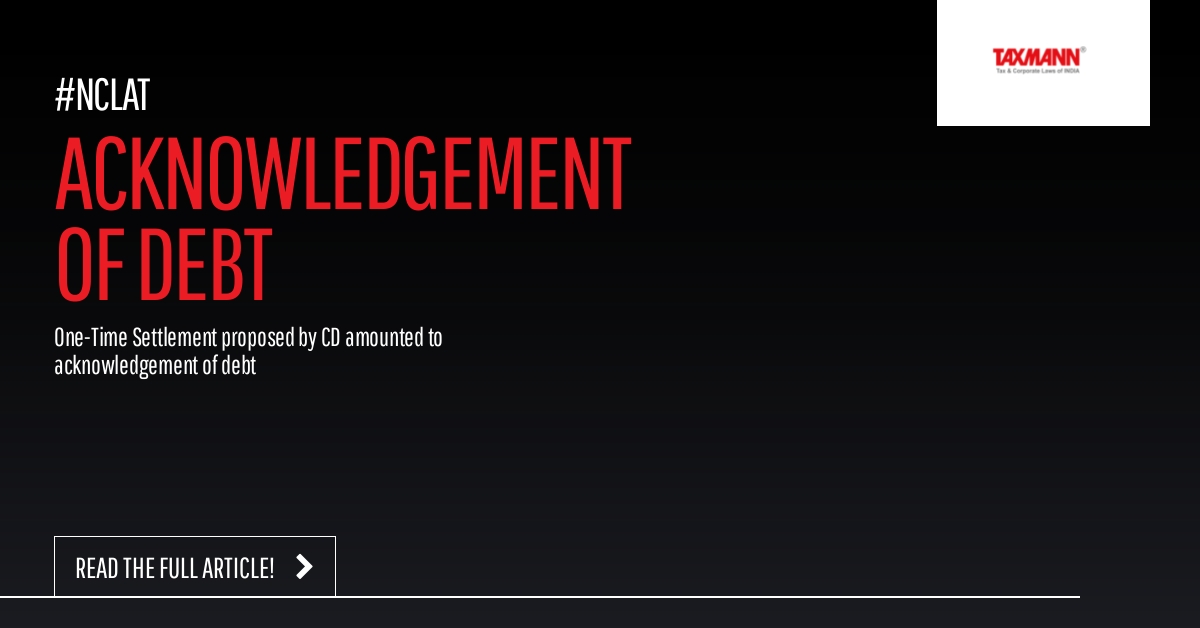One-Time Settlement proposed by CD amounted to acknowledgement of debt: NCLAT
- Blog|News|Insolvency and Bankruptcy Code|
- 2 Min Read
- By Taxmann
- |
- Last Updated on 23 March, 2022

Case Details: Gulabchand Jain v. Punjab National Bank - [2022] 136 taxmann.com 194 (NCL-AT)
Judiciary and Counsel Details
-
- Justice Ashok Bhushan, Chairperson and Dr. Alok Srivastava, Technical Member
- Rajesh Bohra and Ms. Sangeeta Bohra, Advs. for the Appellant.
- Shivanshu Kumar and Atul Sharma, Advs. for the Respondent.
Facts of the Case
The Appellant took financial credit from Punjab National Bank (PNB). The account was declared NPA on 13-6-2009. The Bank initiated proceedings under SARFAESI Act, 2002 as well as before the Debts Recovery Tribunal which passed a Decree in favour of the bank.
On 31-5-2018, the financial creditor bank filed an application under section 7 for initiation of CIRP against the corporate debtor. The NCLT by impugned order admitted said application.
On appeal, the corporate debtor contended that the application filed on 31-5-2018 was well beyond the period of limitation and could not have been admitted.
The Respondent argued that the application filed by the PNB u/s 7 of the Code was well within time. In support of his case, he made three submissions.
a) Firstly, he submitted that he is covered by section 14 of the Limitation Act for the period during which application was pending before the DRT.
b) He further submitted that there are acknowledgements by the Corporate Debtor in the year 2011, 2012 & 2016, in which One Time Settlement (OTS) offers were made, which is acknowledgement within the meaning of section 18 of the Limitation Act and which will give an extension of limitation.
c) Lastly, he submitted that in view of the Decree issued by order dated 6-10-2017 of the DRT, the Bank will have a fresh period of limitation of three years from 6-10-2017 and the application filed by the Bank is within three years which is well within time.
NCLAT Held
The NCLAT held that by the decree passed on 6-10-2017 financial creditors should get a fresh period of limitation of three years and an application under section 7 having been filed within 3 years from 6-10-2017 could not be held to be barred by limitation.
It was held that since the corporate debtor had written letter to the financial creditor giving a proposal for OTS for outstanding dues, letters acknowledging debt issued by corporate debtor should give benefit to the financial creditor for extension othe f limitation period and, thus, an application filed under section 7 could not be said to be barred by limitation.
Case Review
-
- Vijay Timber Industries v. Punjab National Bank [2022] 136 taxmann.com 193 (NCLT – AHM) (para 12) affirmed [see Annex]
- Dena Bank v. C.Shivkumar Reddy [2021] 129 taxmann.com 60 (SC) (para 11) followed.
- Sesh Nath Singh v. Baidyabati Sheoraphuli Co-operative Bank Ltd. [2020] 114 taxmann.com 282/158 SCL 211 (NCLAT – New Delhi) (para 9) distinguished.
List of Cases Referred to
-
- Sesh Nath Singh v. Baidyabati Sheoraphuli Co-operative Bank Ltd. [2020] 114 taxmann.com 282/158 SCL 211 (NCLAT – New Delhi) (para 2)
- B. K. Educational Services (P.) Ltd. v. Parag Gupta & Associates [2018] 98 taxmann.com 213/150 SCL 293 (SC) (para 2)
- Dena Bank v. C. Shivakumar Reddy [2021] 129 taxmann.com 60 (SC) (para 10).
Disclaimer: The content/information published on the website is only for general information of the user and shall not be construed as legal advice. While the Taxmann has exercised reasonable efforts to ensure the veracity of information/content published, Taxmann shall be under no liability in any manner whatsoever for incorrect information, if any.

Taxmann Publications has a dedicated in-house Research & Editorial Team. This team consists of a team of Chartered Accountants, Company Secretaries, and Lawyers. This team works under the guidance and supervision of editor-in-chief Mr Rakesh Bhargava.
The Research and Editorial Team is responsible for developing reliable and accurate content for the readers. The team follows the six-sigma approach to achieve the benchmark of zero error in its publications and research platforms. The team ensures that the following publication guidelines are thoroughly followed while developing the content:
- The statutory material is obtained only from the authorized and reliable sources
- All the latest developments in the judicial and legislative fields are covered
- Prepare the analytical write-ups on current, controversial, and important issues to help the readers to understand the concept and its implications
- Every content published by Taxmann is complete, accurate and lucid
- All evidence-based statements are supported with proper reference to Section, Circular No., Notification No. or citations
- The golden rules of grammar, style and consistency are thoroughly followed
- Font and size that’s easy to read and remain consistent across all imprint and digital publications are applied





